
* In the 1960s, the Mitsubishi company of Japan introduced a twin-turboprop light transport, the "MU-2", that proved very successful. It was followed in the early 1980s by the "MU-300 Diamond", which was also successful, though most production of that variant was by Beechcraft. Mitsubishi later attempted to develop the "Mitsubishi SpaceJet" regional airliner, but it never went beyond prototypes. This document gives a history and description of the MU-2, MU-300, Spacejet -- and also the Honda "HA-420 HondaJet" light executive jet.
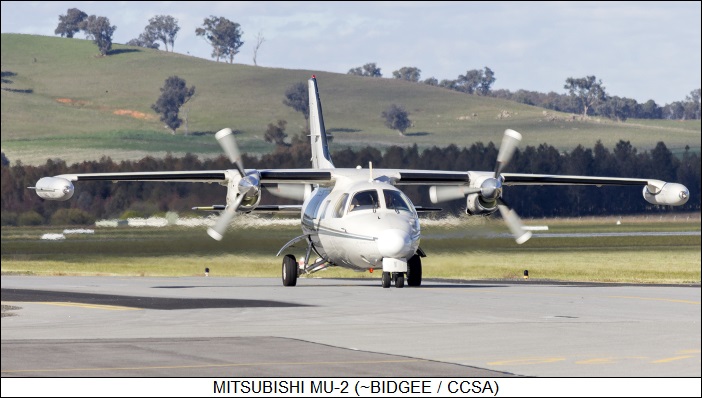
* In 1956, the Mitsubishi firm of Japan, famed for its World War II Zero fighter, began work on its first postwar aircraft design -- a light twin turboprop transport for civil and military use. The result, the "XMU-2", performed its initial flight on 14 September 1963. This first prototype, and the three initial series "MU-2A" pre-production machines, were powered by Turbomeca Astazou Mark II turboprops with 420 kW (562 SHP), driving three-bladed reversible Hartzell props.
Following the MU-2A, 34 production "MU-2B" machines were then produced, along with an upgraded MU-2A, all powered by Garrett TP331-25AA or -25AB turboprops with 430 kW (575 SHP) each -- not counting a fair effective additional increment of power from exhaust thrust. Some sources also claim that the MU-2B had a wider wingspan than the first four MU-2s. All subsequent MU-2 variants had TPE331 engines, including a series of stretched machines, discussed later. Incidentally, the name "Peacock" is associated with the MU-2, but it's not often used in literature, and may have been a late innovation.
The MU-2 -- "Mitsubishi Utility 2"-- was built mostly of aircraft aluminum. It featured high, straight, flat wedge-shaped wings, a wedge-shaped tailplane with narrow leading-edge root extensions, a swept tailfin with a smoothly curving forward fillet, and tricycle landing gear. The wing featured full-span trailing-edge double slotted flaps, with roll control provided by spoilers; the full-span flaps ensured a low stall speed on take-off and landing, while the spoilers could provide more effective control at low speeds than ailerons. Flight control surfaces were manually driven, except for electrically-driven flaps.
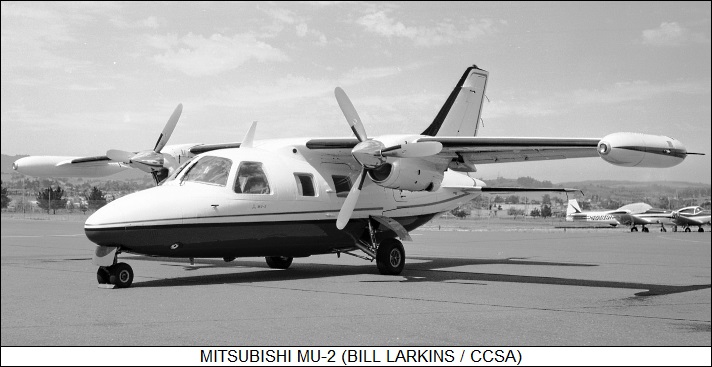
The twin-wheel nose gear retracted backward, while the single-wheel main gear tucked up into the sides of the fuselage. The landing gear was electrically actuated. The MU-2B had integral wing tanks and fixed wingtip tanks with a capacity of 246 liters (65 US gallons) each; the tip tanks were not fitted to the XMU-2 or MU-2As. They were quickly replaced in later variants by extended wingtip tanks with 341 liters (90 US gallons) each, with late-production variants also featuring four-bladed Hartzell propellers. There were two cockpit crew and seats for seven passengers, with the passenger door on the left rear fuselage, hinged on the left, and an emergency exit under the right wing. The aircraft was pressurized and climate-conditioned.
___________________________________________________________________
MITSUBISHI MU-2K:
___________________________________________________________________
wingspan:
11.94 meters (39 feet 2 inches)
wing area:
16.55 sq_meters (178 sq_feet)
length:
10.13 meters (33 feet 3 inches)
height:
3.94 meters (12 feet 11 inches)
empty weight:
2,685 kilograms (5,920 pounds)
max take-off weight:
4,500 kilograms (9,920 pounds)
cruise speed:
585 KPH (365 MPH / 315 KT)
service ceiling:
10,120 meters (33,200 feet)
range:
2,705 kilometers (1,680 MI / 1,460 NMI)
___________________________________________________________________
Not everyone was enthusiastic about the MU-2's looks, but it did have a clean and businesslike appearance. The MU-2 had plenty of power and was regarded as a "hot" aircraft in its class; it also had good short-field performance. The MU-2 had a high accident rate initially, partly due to design issues that were soon rectified; more so because pilots weren't used to its high performance, or the fact that it handled differently under engine-out conditions than other small prop twins. Recommendations for improved flight procedures and training reduced the accident rate to a much more tolerable level, and the MU-2 would become recognized as being at least as safe as any other aircraft in its class.
* After initial manufacture in Nippon, Mitsubishi set up an arrangement with Mooney in the USA to built, sell, and support the MU-2 internationally, with Mooney setting up an assembly plant in San Angelo, Texas, in 1965. Major assemblies were shipped from Japan, with Mooney installing engines and props, avionics, then fitting out the interior. In 1969, Mooney was in financial trouble, so Mitsubishi took over the San Angelo plant. Following the MU-2B, variants included:
As mentioned above, there were two specialized militarized variants of the short-fuselage MU-2s. The first was the "MU-2C (MU-2B-10)", which was built for the Japan Ground Self-Defense Forces (JGSDF), service designation being "LR-1". It was for liaison and photo-reconnaissance work, with a vertical and an oblique camera in the belly. Four MU-2Cs were built, the first having no wingtip tanks -- this apparently being the only production MU-2 that didn't have them -- instead having an extra fuel tank in the rear. The JGSDF then acquired 16 MU-2Ks in the same configuration, also giving them the "LR-1" designation (for "Liaison-Reconnaissance"), for a total of 20 LR-1s. There are photos of some of the LR-1s with "cheek" fairings that could be used to accommodate more surveillance gear and even machine guns, but this doesn't appear to have been a normal fit.
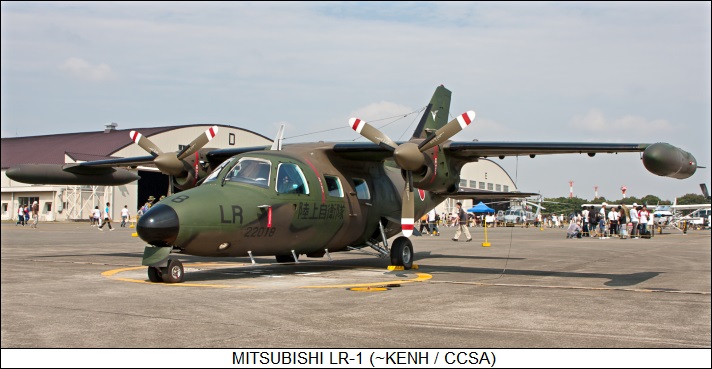
The second was the "MU-2E", internal designation unknown, a search and rescue (SAR) variant of MU-2DP for Japan Air Self-Defense Forces (JASDF), service designation being "MU-2S". It featured radar in a thimble nose radome, bulged observation windows, larger fuel supply, and a sliding door that could be opened in flight for dropping rescue kit. 16 MU-2Es were obtained. Images suggest that some of them had the small wingtip tanks, though most had the big tanks.
No foreign military services acquired specifically militarized MU-2s, but from the late 1980s the US Air Force acquired a fleet of MU-2K and MU-2M machines, to be flown from Tyndall Air Force Base in Florida for "Air Battle Management (ABM)" training. The MU-2s simulate opposing fighter teams, with ABM controller trainees directing their respective teams. The MU-2s still seem to be in service at Tyndall, being given an engine upgrade from 2012.
* The first of the stretched MU-2 variants was the "MU-2G (MU-2B-30)", which featured a fuselage stretched by 1.91 meters (6 feet 3 inches), for seating 8 to 11 passengers; main landing gear in sponsons to free up internal space; forward-retracting nose gear; a larger, straight-edged tailfin fillet; and twin fixed ventral fins under the tail. Despite its greater size, it retained the TPE331-1-151A engines, with the 495 kW (665 SHP) derating. Initial flight was on 10 January 1969; 46 were built.
___________________________________________________________________
MITSUBISHI MU-2J:
___________________________________________________________________
wingspan:
11.94 meters (39 feet 2 inches)
wing area:
16.55 sq_meters (178 sq_feet)
length:
12.01 meters (39 feet 5 inches)
height:
4.17 meters (13 feet 8 inches)
empty weight:
3,085 kilograms (6,800 pounds)
MTO weight:
4,900 kilograms (10,800 pounds)
cruise speed:
555 KPH (345 MPH / 300 KT)
service ceiling:
9,320 meters (30,800 feet)
range:
2,500 kilometers (1,555 MI / 1,350 NMI)
___________________________________________________________________
The MU-2G was followed by refined stretched variants:
There were no specialized military variants of the stretched MU-2s, but the JASDF obtained four MU-2Js for navaids calibration duties, and apparently some military services obtained a few for utility and liaison work.

* The following list gives MU-2 variants and production, with short and long versions marked as "S" or "L" respectively:
That gave total production of 743, though sources vary on the numbers. The majority of MU-2s were built in the US, where production ended in 1986. The last Japan-built MU-2 was rolled out in early 1987. The MU-2 remains in widespread civilian service, most machines still having plenty of airframe life remaining. There have been third-party upgrades of MU-2s for cargo, combination cargo-passenger, and medical evacuation use, while upgrades have been on offer to fit MU-2s with a modern "glass cockpit".
BACK_TO_TOP* In the mid-1970s, Mitsubishi began work on an executive jet, with the first of two "MU-300 Diamond" prototypes performing its initial flight on 29 August 1978, with the second following in December. As it emerged, the Diamond was of conventional executive jet configuration, with all-swept flight surfaces including a low mounted wing and tee tail; turbofans mounted on each side of the tail; and tricycle landing gear. Following development, the two prototypes were shipped to Mitsubishi Aircraft International INC, the parent company's American subsidiary, for certification as the "Diamond I". FAA certification was granted in late 1981, with initial customer shipments in the summer of 1982. 63 Diamond Is were built at the plant in San Angelo, Texas, using assemblies shipped from Japan.
The Diamond I was made mostly of aircraft aluminum alloy. Its wings had a sweepback of 20 degrees at quarter chord and an incidence of three degrees. Each wing had trailing-edge flaps running almost the full span, with double slotted flaps inboard and single slotted flaps outboard, with a small aileron near each wingtip. There were spoilers above the wing to aid in roll control, as well as to act as airbrakes and lift dumpers. There was a small fence about a third of the way outboard on the wing. De-icing was by engine bleed air.
The tailfin had a long leading fillet, with a small yaw damper surface above the rudder. The tailplane featured elevators, and had variable incidence to handle flight trim. There was a ventral fin under the tail, and a small strake along each side of the tailfin. All landing gear assemblies had single wheels, the main gear hinging in the wings to retract towards the fuselage, the steerable nose gear retracting forward.
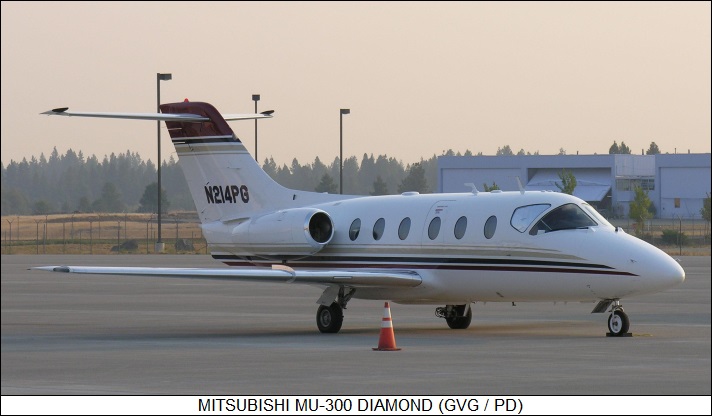
Powerplants were Pratt & Whitney Canada (PWC) JT15D-4 turbofans with a take-off thrust of 11.1 kN (1.146 kgp / 2,500 lbf) thrust each, max cruise thrust being 94% of that. There were fuel tanks in the tail and integral wing tanks, with a total maximum useful capacity of 2,445 liters (646 US gallons). There were three refueling points, one in each wing, one in the tail.
___________________________________________________________________ MITSUBISHI MU-300 DIAMOND I: ___________________________________________________________________ wingspan 13.23 meters 43 feet 5 inches wing area 22.43 sq_meters 214.4 sq_feet length 14.73 meters 48 feet 4 inches height 4.19 meters 13 feet 9 inches empty weight 3,765 kilograms 8,300 pounds MTO weight 6,395 kilograms 14,100 pounds cruise speed 760 KPH 470 MPH / 410 KT service ceiling 12,500 meters 41,000 feet range 2,315 kilometers 1,440 MI / 1,250 NMI ___________________________________________________________________
There were two flight crew and, typically, seven seats, with a toilet and a baggage compartment in the rear. Of course, the aircraft was pressurized and climate-conditioned. There was a front-hinged passenger door on the left side of the fuselage in front of the wing, with fold-down airstair, and an emergency exit on the right side of the fuselage, above the front of the wing root. Avionics were conventional, including radios, navigation aids, air traffic control transponder, and color weather radar.

* In 1983, Mitsubishi announced development of the improved "Diamond IA", with uprated JT15D-4D turbofans, an electronic flight instrumentation system (EFIS), and increased MTOW; another window was added on the left side of the fuselage. Initial deliveries were in 1984, with 27 built.
Mitsubishi then developed a further improved variant, with JT15D-5 engines, lower MTOW but increased fuel capacity, as the "Diamond II". Mitsubishi only built a prototype, selling off the design to Beech in 1985, which then built 64 as the "Beechjet 400" from Mitsubishi assemblies. The production machines featured thrust reversers. In 1989, Beech introduced the "Beechjet 400A", featuring a Collins Pro Line 4 avionics system, including a glass cockpit, and a rearranged interior.
In 1990, Beech won a contract from the US Air Force for what would end up being a total of 180 slightly modified Beechjet 400s as the "Tanker / Transport Training System", for training KC-135, C-5, KC-10 and C-17 aircrews. Differences included militarized avionics, with the avionics moved from nose to rear to simplify maintenance; an additional fuselage fuel tank, along with single-point refueling; better air conditioning; plus windshield and leading-edge reinforcement to deal with birdstrikes. The modified aircraft was designated the "Beech 400T T-1A Jayhawk", with initial deliveries in 1991 and introduction to service in 1992.
The Jayhawk normally flew just with trainee and instructor, but it could be fitted with four seats for passengers or observers. From 1997, the Jayhawk fleet was fitted with GPS navigation receivers; from 2018, it was refitted with a new avionics suite -- featuring a Collins Pro Line 21 "glass cockpit", and an ADS-B flight-surveillance system -- to better reflect modern USAF operational aircraft, and to meet contemporary air traffic control standards. In something of an irony, the JASDF also obtained 13 400T trainers, similar to the T-1A but with thrust reversers.
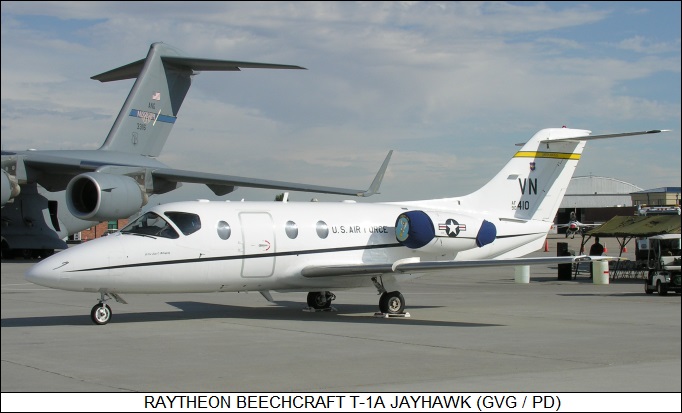
In 1993 Raytheon, the parent company of Beech since 1980, bought the Hawker business jet product line from British Aerospace, with the Beechjet 400 then becoming the "Raytheon Hawker Beechcraft 400" to map it into the Hawker product line. In 2003, production went on to the "Hawker 400XP", the "XP" standing for "extra payload", with a 90-kilogram (200-pound) increase in MTO, thrust reversers, plus avionics and systems updates.
In 2006, Raytheon sold off Beechcraft, with the spun-off company announcing a "Hawker Beechcraft 450XP" in 2008. It was canceled in 2009 due to the slow economy, which was just a prelude to the bankruptcy of the firm in 2013. Beechcraft did emerge again after a re-organization, but dropped the jet product line. A total of 953 400A / 400XP machines had been sold to that time, not including the military trainers.
* Textron bought up Beechcraft in 2014. The company still supports the 400 series, but it got competition in that domain from Nextant Aerospace, a startup that was born in 2007 to remanufacture and update old business jets. The first product introduced by the firm was the "Nextant 400XT", a rebuilt and modernized 400A/XP with:
FAA certification was in 2011. Hawker Beechcraft had been pushing a similar update, the "400XPR", which disappeared when the firm when bankrupt. In 2013, Nextant introduced the refined "400XTi", with a refined and more spacious cabin with better noise insulation, winglets, and other tweaks such as lithium batteries instead of lead-acid batteries. A slightly detuned and cheaper "400XTe" upgrade was introduced in 2019. The company also offered a modest "400X" upgrade, retaining the JT15D engines -- but with a zero-lifed airframe, updated avionics, and options for a new interior and winglets.
Textron struck back to finally introduce the 400XPR in 2017. It featured winglets, an updated interior and colors, plus FJ44-4A engines, with a choice of a Rockwell Collins or Garmin glass flightdeck.
BACK_TO_TOP* In 2004, the Mitsubishi firm of Japan announced development of the "Mitsubishi Regional Jet (MRJ)" small airliner, a twin-engine jetliner with a capacity of 70 to 90 passengers. Development was to be conducted by the Mitsubishi Aircraft Corporation, a partnership between majority owner Mitsubishi Heavy Industries and Toyota Motor Corporation, with assistance from Fuji Heavy Industries, a Toyota affiliate with experience in aircraft manufacture.
A cabin mockup and a model were displayed at the 47th Paris Air Show in 2007, with official program launch in 2008. The first of five MRJ flight prototypes was rolled out in October 2014, with initial flight on 11 November 2015. The test program also included two ground-test articles. The prototypes were of the "MRJ90", with a nominal seat capacity of 90 passengers; it was to be followed by the shorter "MRJ70", with a nominal capacity of 70 seats. In 2019, the aircraft was renamed the "SpaceJet", with the two models becoming the "SpaceJet M90" and "SpaceJet M100" -- the M100 replacing the MRJ70 to meet US category requirements.
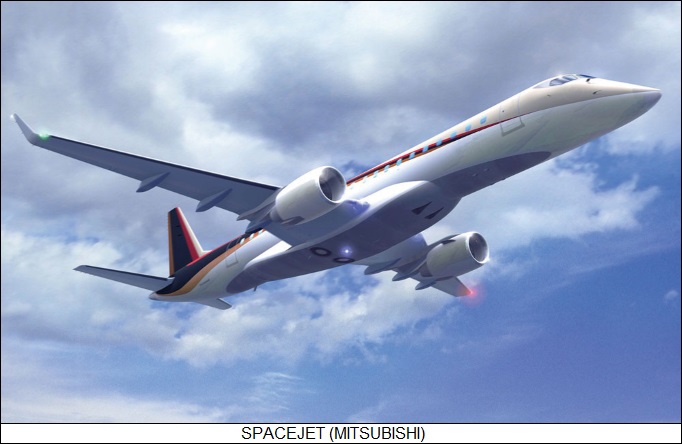
The Mitsubishi SpaceJet was of ordinary regional jetliner configuration, being a narrow-body aircraft with tricycle landing gear, a low-mounted wing, and swept flight surfaces -- the tailfin having a forward fillet. Although it was initially defined as an "all composite" aircraft, that was judged too aggressive, and it ended up being primarily made of aircraft aluminum alloy, with a minority of composite assemblies, mostly in the tail section. It was powered by twin Pratt & Whitney PW1217G geared turbofans, with 78.3 kN (7,980 kgp / 17,600 lbf) thrust each, one engine under each wing. The engines were not only highly efficient, they had low noise and emissions.
The wing featured Fowler flaps, ailerons, and leading-edge slats. The tail assembly was of conventional configuration, with rudder and elevators, the tailplane being all-moving. Flight controls were operated via a fly-by-wire flight-control system. All landing gear assemblies had twin wheels, the nose gear retracting forward, the main gear retracting inward from the inner wings towards the fuselage. The nose had a distinctive "duckbill" configuration.
___________________________________________________________________
MITSUBISHI SPACEJET M90:
___________________________________________________________________
wingspan:
29.2 meters (95 feet 10 inches)
length:
35.8 meters (117 feet 6 inches)
height:
10.5 meters (34 feet 6 inches)
empty weight:
25,190 kilograms (55,535 pounds)
MTO weight:
39,600 kilograms (87,300 pounds)
max speed:
Mach 0.78
service ceiling:
11,855 meters (39,000 feet)
range:
1,665 kilometers (1,035 MI / 900 NMI)
___________________________________________________________________
There were two cockpit crew, the cockpit featuring a Rockwell Collins Pro Line Fusion glass cockpit, with four color displays. The M90's passenger configuration was up to 88 seats, in rows of four, with large-capacity overhead bins. There was a lavatory and a galley fore and aft, and a single cargo bay, in the rear. There were passenger doors fore and aft of the wing on the left side of the fuselage, with matching service doors on the right side, plus an emergency exit over each wing. An "extended range (ER)" variant, with range stretched to 1,665 kilometers (1,035 miles / 900 NMI) was planned, as well as a "long range (LR)" variant with range stretched to 3,295 kilometers (2,050 miles / 1,780 NMI).
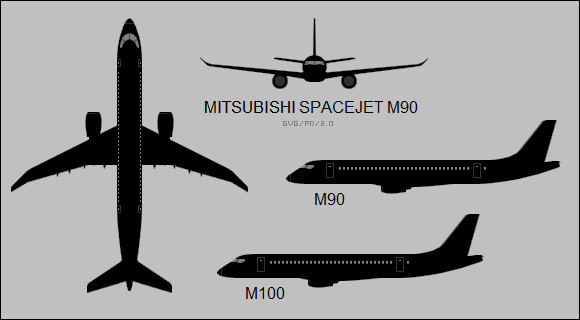
The M100 was to be 1.3 meters (7 feet 10 inches) shorter than the MRJ90, giving a length of 34.5 meters (113 feet 2 inches), 96% that of the MRJ90, and passenger capacity of 76 seats. However, it didn't fly, since the COVID-19 pandemic of 2020:2021 threw the air transport industry into disarray, with the SpaceJet program shelved. There is no sign it will be revived.
BACK_TO_TOP* In the late 1980s, the Honda company of Japan began to investigate a modern small business jet using the latest technologies, working with Mississippi State University's Raspet Flight Research Laboratory to build the "MH02" demonstrator, which performed its first flight on 5 March 1993. It featured a composite aircraft, a tee tail, a forward-swept wing, and a turbofan engine mounted above each wing. This engine placement scheme had been used on the unsuccessful German VFW-Fokker 614 jetliner in the 1970s, in that case simply to reduce weight and guard against foreign object ingestion; Honda saw it as useful for reducing high-speed drag, and wanted to investigate further.
The MH02 demonstrator was retired in the late 1990s, with Honda moving towards a production machine from that time. In 1999, the company began work on a small turbofan engine, the "HF118"; it led to the "HF120", developed in collaboration with GE Aviation. Work also proceeded on the "HA-420 HondaJet" production business jet, with a demonstrator performing its maiden flight on 3 December 2003, making its public debut at the EAA AirVenture air show in Oshkosh, Wisconsin, in July 2005. Honda began taking orders in 2006.
Honda set up the Honda Aircraft Company subsidiary to handle qualification, production, and sale of the HondaJet. Manufacture was to be performed in the USA, at Piedmont Triad International Airport in Greensboro, North Carolina. Initial flight of a pre-production was on 21 December 2010. The first production HondaJet performed its initial flight on 27 June 2014, and was displayed at the 2014 EAA Airventure.
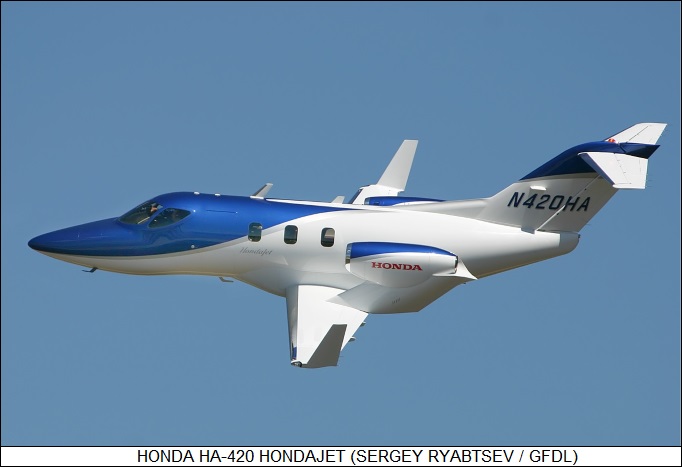
* As introduced, the HondaJet was distinctly Japanese in appearance, looking like something out of an anime. It was a low-wing wing aircraft, the fuselage being made primarily of composites, with aluminum wings and tailplane. It had tricycle landing gear; tapered wings and slightly swept tailplane; a swept tailfin with a forward fin fillet; and a turbofan mounted above and to the rear of each wing. The advantage of top-mounting is reduced weight and drag; the problem is that engine intake airflow can cause aerodynamic problems for the wings, a difficulty that Honda got around by placing the engines almost completely behind the wing. The topside mounting also reduced ground noise and vibration into the passenger compartment, as compared to tail mounting; as well as reduced the risk of foreign object ingestion into the engine during runway operations.
The distinctive drooped nose had a "laminar flow" configuration to reduce drag, while the cockpit was slightly domed to improve headspace. The engines were production HF-120 turbofans with FADEC, providing 8.9 kN (853 kgp / 1,880 lbf) thrust each; they were highly efficient and had low emissions. There were fuel tanks in each wing, in the wing center section, and in the rear fuselage, with single-point refueling.
___________________________________________________________________
HONDA HA-420 HONDAJET:
___________________________________________________________________
wingspan:
12.15 meters (39 feet 10 inches)
length:
12.71 meters (41 feet 8 inches)
height:
4.03 meters (13 feet 2 inches)
max speed:
785 KPH (490 MPH / 425 KT)
service ceiling:
13,100 meters (43,000 feet)
range:
2,185 kilometers (1,355 MI / 1,180 NMI)
___________________________________________________________________
Flight controls were of conventional arrangement -- one-piece flaps, ailerons, rudder, elevators, with manual actuation, except for electrically-driven flaps. There were trim tabs for all three axes of flight. Engine bleed air was used for wing de-icing, though an electromechanical scheme was used for tail de-icing; the engine inlets were de-iced as well, presumably by engine bleed air. All landing gear assemblies had single wheels, with the main gear pivoting from the inner wings to retract towards the fuselage, the nose gear retracting forward. Retraction was by hydraulic actuation, with the nose wheel featuring electronic steering.
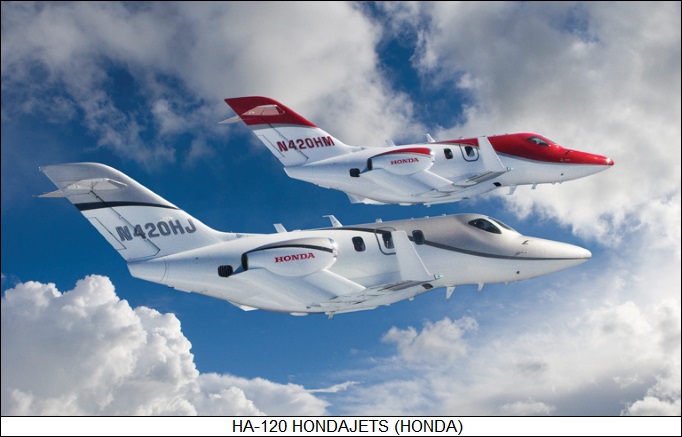
The cockpit had dual controls and featured a Garmin 3000 flight deck, with three large color flat-panel displays across the dash, and two small touchscreen controllers on the center control station. There was an optional side-facing passenger seat on the right, just behind the cockpit, with four seats in a club configuration in the middle of the aircraft. There was a lavatory behind the passenger compartment, and a baggage compartment behind that. The passenger door was on the front left side of the fuselage, being in a hinge-down configuration with integral airstair; there was an emergency exit above the left wing. Of course, the Hondajet was pressurized and climate-conditioned.
Full certification took place in 2015, with initial customer deliveries that December. The original issue was followed by improved variants:
Honda has offered upgrades to enhance older HondaJets to the improved standards. In 2021, Honda Aircraft introduced a "HondaJet 2600" concept, which was an enlarged HondaJet 420 with extended range and up to nine passenger seats, though six was more normal. It was later packaged as the "HondaJet Echelon", with introduction no earlier than 2028.
BACK_TO_TOP* This document was heavily reliant on various volumes of JANE'S ALL THE WORLD'S AIRCRAFT, manufacturer's websites, and video reports on the various aircraft.
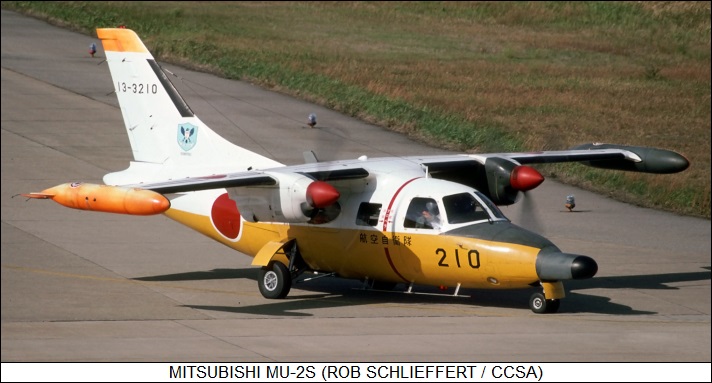
* Revision history:
v1.0.0 / 01 apr 15 v1.0.1 / 01 mar 17 / Review, update, & polish. v1.0.2 / 01 feb 19 / Review, update, & polish. v1.0.3 / 01 feb 21 / Review, update, & polish. v1.1.0 / 01 jan 23 / Review, update, & polish. v1.1.1 / 01 sep 24 / Review, update, & polish. (+)BACK_TO_TOP
